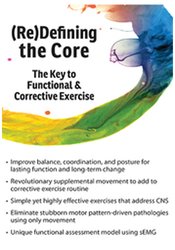(Re)Defining the Core -The Key to Functional & Corrective Exercise – David Lemke
(Re)Defining the Core -The Key to Functional & Corrective Exercise – David Lemke has the same quality as the author’s salapage.
Overview
Salepage check: (Re)Defining the Core -The Key to Functional & Corrective Exercise
Author: David Lemke
- Faculty:
- David Lemke
- Duration:
- 5 Hours 29 Minutes
- Format:
- Audio and Video
- Copyright:
- Jul 13, 2018
Description
Clinicians understand that lasting pain relief and truly improved fitness depend on core stability and peripheral mobility. But long-term results are elusive! It is generally agreed that to have peripheral mobility, you must have core stability. Functional exercise is any exercise which acknowledges this and engages the body for this express purpose.
Observe how EMG explores the primary defensive bias governing the Central Nervous System, the body’s true Core. Once we have observed this bias, which we’ll call the “Twist,” we discuss how it leads to the most common functional problems. Rather than focusing on targeting areas for strength or stability, participants learn to correct movement dysfunction by directing appropriate exercise toward the CNS. These methods can be easily learned and applied by athletic trainers and related health and fitness professionals, massage therapists, physical and occupational therapists – anyone who uses exercise as part or all of their program. You will complete this recording equipped with new knowledge and strategies to help move clients and patients through the vital steps toward lasting function: improved balance, coordination, and effortless posture.
Handouts
| Manual – (Re)Defining the Core (4.50 MB) | 63 Pages | Available after Purchase |
Outline
VITAL DEFINITIONS: ESSENTIAL ELEMENTS OF CORE COMMUNICATION
- Correctly defining the CORE is key to functional training
- Rules of communication
- How the technology explosion in healthcare impairs genuine communication
- Why outcomes have not improved in an age of research data availability
- The Definition Game: 10 ill-defined words we all rely on every day
LAB: KINESIOLOGICAL SURFACE EMG TESTING
- Volunteers selected, skin preparation, system test
- Single arm raise task in standing
- Video and sEMG recording of test activity
- We take requests: “Any movement you’re curious about? Let’s test it!”
MUSCLES 101
- Learning how the CNS sees muscles
- Reviewing sEMG data to observe “chains” vs. groups
- Muscles, mood, and movement (Cuddy, et. al. i.e. current research review)
- CNS perspective: Opposing chains with broken links
- Implications of CNS as CORE: Motor learning in an always on, 24/7, learning, adapting system
WHAT IS THE CORE TWIST: HOW THE HUMAN MOTOR SYSTEM TRAINS ITSELF
- Lower quarter symptoms – most common underlying pathologies – the Core pattern as driver
- Upper quarter symptoms – most common pathologies – the Core pattern as driver
- Review of definitions from the Definition Game
- How far off were we?
- Recognizing the simple elegance of functional chains
TRAINING FUNCTIONAL CHAINS: EXERCISING OUT OF THE TWIST
- Training vs. exercise: Targeting the CNS with structured, resisted movement
- Opposing teams or an orchestra at work?
- Crosstraining out of the Twist
- Any exercise NOT countering the Twist is NOT Functional
LAB: THE FUNCTIONAL CHAIN GAME
- Workshop it !
- Demo and practice: XC Skiing, backwards resisted walking, etc.
- Best of the group brainstorming: FCT demo and SkiX activity
- Signs of success: Posture, balance, and youthful boldness
Faculty
David Lemke, NMT, sEMG Tech Related seminars and products: 2
David Lemke, NMT, sEMG Tech, became interested in core function as a patient with back pain. Following pain relief and functional improvement brought about by gifted and well-trained manual therapists, he began his own apprenticeship with a renowned Canadian bodyworker in 1985.
Ten years into his own practice, Mr. Lemke made a breakthrough using information from a kinesiological surface electromyography (sEMG) evaluation. His discovery: that adding a single muscle manipulation to a parascapular trigger point sequence freed a borderline frozen shoulder and eliminated nearly all the pain – with lasting results uncommon to this type of manipulation. The treatment, later described as a sequenced motor point manipulation, became the subject of studies conducted by physical therapists at Idaho State University.
Since that time, Mr. Lemke’s sEMG assessments and motor point treatments have been relied on by top performing athletes, dancers, martial artists, and those recovering from orthopedic injuries and surgeries. As a passionate interest, Mr. Lemke has enjoyed working with special education teachers treating motor coordination problems in children diagnosed with learning disabilities.
He is a Certified Dartfish Video Coach and uses slow motion video analysis of biomechanics in his clinic. Mr. Lemke’s expertise using kinesiological sEMG is well known in the field, as he has tested exercise equipment, devices, and new treatment procedures as well as trained hundreds of specialized neuromuscular massage and physical therapists.
Mr. Lemke was the primary consultant to Champions Sports Medicine (Spokane, WA) in the creation of their Biomechanics lab and consults regularly with researchers at Baylor University’s Human Motion Lab. Learn more at davelemke.us
Speaker Disclosures:
Financial: David Lemke receives commissions from Bioperformance Texas LLC and Flexsolate for demonstration and sales of the Functional Chain Trainer, as well as consulting. He receives a speaking honorarium for PESI, Inc.
Non-financial: David Lemke has no relevant non-financial relationships to disclose.
Curriculum
FAQs
Requirements
- A basic understanding of human anatomy and biomechanics.
- Access to a stable internet connection to stream or download the digital course.
- A commitment to practical learning through functional and corrective exercises.
- A willingness to apply the concepts learned to real-world fitness or rehabilitation settings.
Features
- Comprehensive insights into core biomechanics and functional movement.
- Step-by-step guidance on corrective exercises for enhanced performance.
- Access to video demonstrations and expert commentary from David Lemke.
- Practical applications tailored for fitness and therapeutic settings.
- Digital access allows learning at your own pace and convenience.
Target audiences
- Fitness professionals, personal trainers, and physical therapists.
- Sports coaches and rehabilitation specialists seeking to enhance their expertise.
- Individuals passionate about fitness and functional movement.
- Students and professionals in kinesiology, physiotherapy, or related fields.



